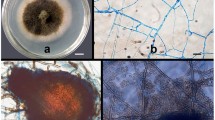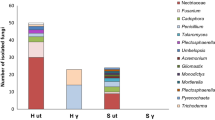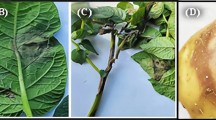Abstract
Free-branching poinsettia cultivars that produce numerous axillary shoots are essential for propagating desirable multi-flowered poinsettias (Euphorbia pulcherrima Wild. Klotz). For more than a decade, a biological agent has been suspected to cause free-branching in poinsettias. Attempts to identify the branching agent have failed. Isolation of the pathogen was accomplished using a living host and it was concluded that an unculturable phytoplasma is the cause of free-branching in poinsettias. This is the first reported example of a pathogenic phytoplasma as the causal agent of a desirable and economically important trait.
This is a preview of subscription content, access via your institution
Access options
Subscribe to this journal
Receive 12 print issues and online access
$209.00 per year
only $17.42 per issue
Buy this article
- Purchase on Springer Link
- Instant access to full article PDF
Prices may be subject to local taxes which are calculated during checkout
Similar content being viewed by others
References
Kaplan, J.K. 1992. A blooming industry. Agricultral Research 12: 4–7.
Ecke Jr, P., Matkin, O.A., and Hartley, D.E. 1990. The Poinsettia Manual, 3rd ed. Paul Ecke Poinsettias, Encinitas, CA.
Floriculture Crops 1995 Summary. 1996. National Agricultural Statistics Service, USDA, Washington, D.C.
Dole, J.M. and Wilkins, H.F. 1991. Vegetative and reproductive characteristics of poinsettia altered by a graft-transmissible agent. J. Amer. Soc. Hort. Sci. 116: 307–311.
Dole, J.M., Wilkins, H.F., and Desborough, S.L. 1993. Investigation on the nature of a grafttransmissible agent in poinsettia. Can. J. Bot. 71: 1097–1101.
Ruiz-Sifre, G.V. 1993. Further studies in the transmission of poinsettia branching agent. Ph.D. thesis, Oklahoma State University. Stillwater, Oklahoma.
Stimart, D.P. 1983. Promotion and inhibition of branching In poinsettia in grafts between self-branching and non-branching cultivars. J. Amer. Soc. Hort. Sci. 108: 419–422.
Fulton, R.W. and Fulton, J.L. 1980. Characterization of atymo-like virus common in poinsettia. Phytopathology 70: 321–324.
Koenig, R. and Lesemann, D.E. 1980. Two isometric viruses in poinsettia. Plant Disease 64: 782–784.
Koenig, R., Lesemann, D.E. and Fulton, R.W. 1986. Poinsettia mosaic virus. AAB Descriptions of Plant Viruses, No. 311.
Preil, W. and Engelhart, M. 1982. In vitro separation of chimeras by suspension cultures of Euphorbia pukhanima Willd. Gartenbauwissenschaft 47: 241–244.
Dole, J.M. and Wilkins, H.F. 1992. In vitro characterization of a graft-transmissible free-branching agent in poinsettia. J. Amer. Soc. Hort Sci. 117: 972–975.
McCoy, R.E., Caudwell, A., Chang, C.J., Chen, T.A., Golino, D.A., Hackett, K.J., Kirkpatrick, B.C., Marwitz, R., Petzold, H., Shinha, R.H., Sugiura, M., Whitcomb, R.F., Yang, I.L., Zhu, B.M. and Seemüller, E. 1989. Plant diseases associated with mycoplasmalike organisms. The Mycoplasmas 5: 545–560.
Lee, I.-M. and Davis, R.E. 1992. Mycoplasmas which Infect plants and insects, pp. 379–390 in Mycoplasmas: Molecular Biology and Pathogenesis. Maniloff, J., McElhansey, R.N., Finch, L.R., and Baseman, J.B. (eds.). American Society for Microbiology, Washington, D.C.
Lee, I.-M., Tiffany, M., Gundersen, D.E., and Klopmeyer, M. 1995. Phytoplasma infection: A beneficial factor for production of commercial branching poinsettia cultivars? Phytopathology 85: 1179.
Lee, I.-M., Hammond, R.W., Davis, R.E., and Gundersen, D.E. 1993. Universal amplification and analysis of pathogen 16S rDNA for classification and identification of mycoplasmalike organisms. Phytopathology 83: 834–842.
Gundersen, D.E. and Lee, I.-M. 1996. Ultrasensitive detection of phytoplasmas by nested-PCR assays using two universal primer pairs. Phytopathologia mediterranea 35: 144–151.
Griffiths, H.M., Gundersen, D.E., Sinclair, W.A., Lee, I.-M., and Davis, R.E. 1994. Mycoplasmalike organisms from milkweed, goldenrod, and spirea represent two new 16S rRNA subgroups and three new strain subclusters related to X-disease. Can. J. Plant Pathol. 16: 255–260.
Lee, I.-M., Bertaccini, A., Vibio, M., and Gundersen, D.E. 1995. Detection of multiple phytoplasmas in perennial fruit trees with decline symptoms in Italy. Phytopathology 85: 728–735.
Lee, I.-M., Davis, R.E., Sinclair, W.A., DeWitt, N.D., and Conti, M. 1993. Genetic relatedness of mycoplasmalike organisms detected in Ulmus spp. in the United States and Italy by means of DNA probes and polymerase chain reactions. Phytopathology 83: 829–833.
Preil, W., Florak, R., Wix, U., and Back, A. 1988. Towards mass propagation by use of bioreactors. Acta Horticulture 226: 99–107.
Murashige, T. and Skoog, F. 1962. A revised medium for rapid growth and bioassays with tobacco tissue cultures. Physiol. Plant. 15: 473–497.
Author information
Authors and Affiliations
Rights and permissions
About this article
Cite this article
Lee, IM., Klopmeyer, M., Bartoszyk, I. et al. Phytoplasma induced free-branching in commercial poinsettia cultivars. Nat Biotechnol 15, 178–182 (1997). https://doi.org/10.1038/nbt0297-178
Received:
Accepted:
Issue Date:
DOI: https://doi.org/10.1038/nbt0297-178



